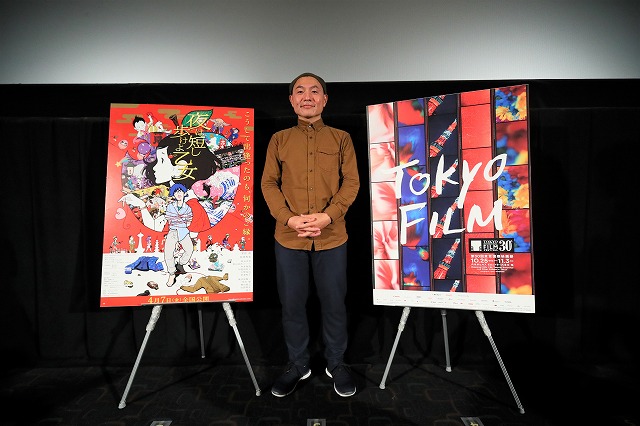
Schedule
Tickets
MarketOutline

The Night is Young, Walk on Girl is animation genius Masaaki Yuasa’s latest intelligent, funny, slightly erotic, wildly wordy romantic romp. Adapted from Tomihiko Morimi’s coming-of-age novel, it concerns a female student (the Girl with Black Hari) who is determined to drink the night away in the backstreet bars of Kyoto following a wedding party.
Her infatuated upperclassman (Sempai) pursues her, attempting to engineer an “accidental” encounter in which he can confess his love. As the night goes on, our heroine moves with breakneck speed through rambunctious going-away parties, used book markets, and school festivals, bumping up against a colorful cast of characters that includes a screenwriting tengu, a cross-dressing high-school heartthrob, and a man who refuses to change his pants and goes by the moniker Don Underwear.
Yuasa was on hand to answer questions on October 26 following TIFF’s screening of the film, his first in a dozen years, in the Japan Now section. “This is a story about ordinary college life,” he said, “so a lot of frivolous events happen in this film. Whether you can enjoy the film depends on your enjoyment of such frivolous things.”
When asked whether it was his intention to create such an experimental and avant-garde work, Yuasa referred to the original novel by Morimi, which is also unique and avant-garde in its own way. One aspect of this experimental quality is a technique revisited from Yuasa’s first adaptation of Morimi’s work, Tatami Galaxy, which pairs ultrafast narration and dialogue with a constant stream of rapid-fire visuals. “The novel revolves around intellectual college students who speak in ways reminiscent of much older novels,” said Yuasa. “But it’s also based in Kyoto, so we strained to communicate the Kyoto-ish quality of the novel through the visuals.”
Yuasa’s version of Kyoto is indeed sexy, sensual and full of the colors of the four seasons. “Perhaps because the characters are always drinking,” he joked. “Representing the beauty of Kyoto was important,” he continued, “but we also wanted to convey a certain aspect of male lust in a very pop style.”
When asked about how he comes up with such a variety of visuals for his work, Yuasa emphasized that novels, manga, film and animation are all different mediums and require their own unique expression. “What’s most important to me is what I felt and imagined when I first experienced that original,” he said. “Hopefully what I imagine is close to what those who read the novel also envisioned.”
The Night is Young moves headlong through the culture of Kyoto’s nightlife and university scene, but what grounds its relentless pace is the coming-of-age romance between the two leads. “They are naïve for university students,” Yuasa elaborated, “and haven’t reached the point of maturation that they desire. The story is about reaching that point.”
The film’s sense of speed is also a comment on how we experience the passage of time throughout our lives. “When you’re young and free, fun times seem to pass slowly, but these same experiences seem to pass very quickly as we get older,” Yuasa said. “At the same time, we also thought that your time becomes enriched — that you gain time back — when you give your time to others. Spending your time on frivolous or wasteful things can also contribute to your own happiness. We adopted this idea as a methodology for the film and ran with it.”
The animation process, said Yuasa, doesn’t differ much from live action in its context dependence on budget, schedule and staff. However, what he thinks is most important is whether the expression is effective for animation or not. “For live action, scenes of spectacle cost the most, but with animation, the scenes that are more difficult to animate are actually scenes of just walking or sitting down,” he explained. “We’ll decide whether or not we can do such scenes depending on the experience of the animators we have.”
Yuasa and his Science Saru studio are helming Devilman Crybaby, an original anime series for Netflix, to be released at the beginning of 2018. “Devilman was a very famous manga from my youth,” he said, “and it’s known for being quite difficult to adapt into animation, but we’ve been able to do it fairly well. We’re busy finishing production this month. It’s really quite interesting, so please check it out.”